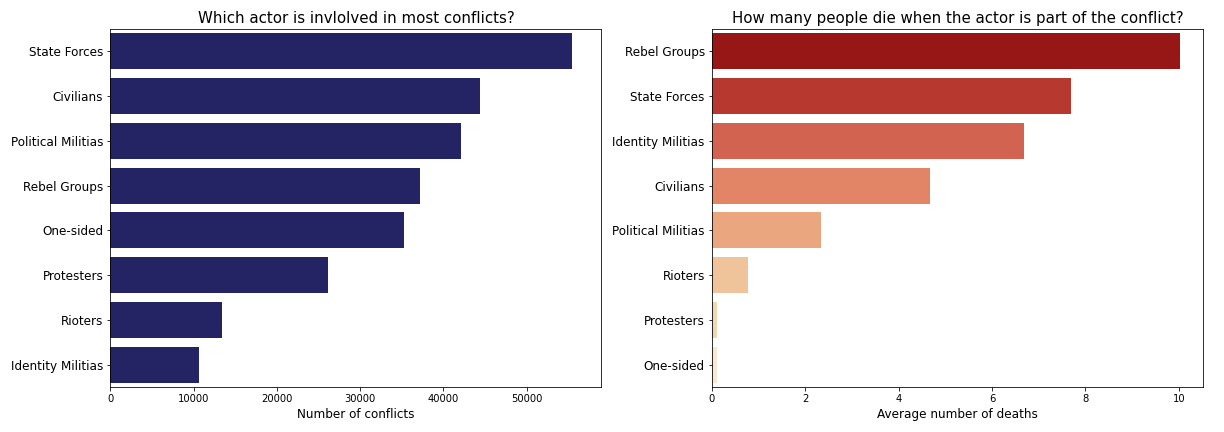Temporal patterns and actors analysis
Temporal patterns
In this section we will dive deeper into different dimensions of this dataset and present the most interesting findings. We will start by investigating the temporal patterns of each of the conflict types. Can we observe any intresting trends in case of some of them?

We decided to use a combination of a line plot with a bar plot to present the relationships between average number of deaths and number of events in time. An interesting thing to see here is that for instance battles (no change of territory) got less deadly. The falling fatalities rate trend also holds for broader category of events that include riots and protests although we can see some spikes. However, they are a result of single events in Egypt in 2011 and 2013, where the protesters demanded the resignation of presidents Hosni Mubarak and later Muhammad Mursi but the general trend is clear.
Additionally, we can also observe how the number of events linked to Remote violence accelerated in the recent years. This can be linked to the activities of extremist groups that resort to the use of suicide bombers [1].
Another thing that we can read from the plot by looking at the range of right axis is that Battle-No change of territory, Violence against civillians and Remote violence are the most deadly types of conflicts.
Lastly, we can conclude that 2005 was the most peaceful year in this period.
Actors
Another interesting thing that caught our attention is the role of actors involved in conflicts. Which type of actor is involved in most conflicts and with which one the highest number of deaths is associated?

As the intuition can suggest, State Forces, defined by ACLED [2] as government functions, including military and police, over a given territory, are part of most of the conflicts in our data. Unfortunately, Civilians are right after them in this ranking.
Another interesting thing we learned from our data is that the deadliest conflicts are conflicts where a Rebel Group is a side of them.
Coming back to the civilians, we wanted to check who fights them the most and we discovered it is the Political Militias type of actor, as presented below.

At first, the phrase Political Militias does not tell much so we again turned to the ACLED codebook [2], where it is said that this type of actor has political goals of influencing and impacting governance, security and policy, however, those groups are not interested in removing the national power, but are even supported by the political elites and act to support their goals. We digged deeper and wanted to see who particularly is hidden behind this category and discovered that most of the groups that fight civilians are named Unidentified Armed Group (followed by the name of the country of origin).
| Actor Name | |
|---|---|
| Unidentified Armed Group (Somalia) | 3258 |
| ZANU-PF: Zimbabwe African National Union-Patriotic Front | 2251 |
| Unidentified Armed Group (Nigeria) | 1395 |
| Unidentified Armed Group (Sudan) | 1321 |
| Unidentified Armed Group (Burundi) | 1031 |
| Unidentified Armed Group (Libya) | 638 |
| Boko Haram - JamaÕatu Ahli is-Sunnah lid-Dawatai wal-Jihad | 562 |
| Unidentified Armed Group (Kenya) | 561 |
| Unidentified Armed Group (South Africa) | 501 |
| Unidentified Armed Group (Democratic Republic of Congo) | 468 |
This can further suggest that, because those armed groups stay unidentified, they can be used by the elites under the guise of anonymity and this way may pursue violent actions without taking any liability for that. Thus, it looks like this is a major threat to the civilians in Africa.
References:
[1] Institute for Security Studies. Violence in Africa Trends, drivers and prospects to 2023. https://www.alnap.org/system/files/content/resource/files/main/ar-12.pdf. 2018. Accessed: 07.05.2021.
[2] Armed Conflict Location & Event Data Project (ACLED) Codebook https://acleddata.com/acleddatanew/wp-content/uploads/dlm_uploads/2019/01/ACLED_Codebook_2019FINAL.docx.pdf?fbclid=IwAR3M1cQJ11zODkrhmBoR8l2uLLO2HXHOPDPM1w43Cd3ip9hD4P0X2jPiaCE